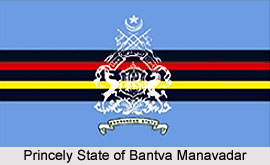 The Princely State of Bantva Manavadar was one of the prominent princely states of India that were administered by native rulers or Indian princes under the indirect control of the British Government of India. The Bantva Manavadar State was amongst main state which was established in 1760 on the Kathiawar peninsula in Gujarat, India. During the rule of the British Empire in India, the region was appointed as one of the princely states of India under the indirect rule of the British East India Company. The princely state covered a total area of around 574 sq km and comprised of mainly Muslim villages. The native ruler, also called as Indian prince by the British, of the state was given the title of Khan Sahib.
The Princely State of Bantva Manavadar was one of the prominent princely states of India that were administered by native rulers or Indian princes under the indirect control of the British Government of India. The Bantva Manavadar State was amongst main state which was established in 1760 on the Kathiawar peninsula in Gujarat, India. During the rule of the British Empire in India, the region was appointed as one of the princely states of India under the indirect rule of the British East India Company. The princely state covered a total area of around 574 sq km and comprised of mainly Muslim villages. The native ruler, also called as Indian prince by the British, of the state was given the title of Khan Sahib.
The Princely State of Bantva Manavadar was under the indirect control of the British Empire in India. However the native ruler of the state was given autonomous power to administer the internal issues of the state. Moreover the royal family maintained harmonious association and alliance with the British administration and provided support to the British troop as well. The British in return provided security and protection to the ruler of the state from external forces. After the nation attained independence and the withdrawal of British Government, the last ruler of the princely state of Bantva Manavadar, Khan Sahib Ghulam Moinuddin Khanji, acceded his state to the Dominion of Pakistan on 14 September 1947. This was done simultaneously with the accession of the Junagadh. Later on 22 October 1947, the Indian police forces were sent into Bantva Manavadar and the former Khan Sahib was detained and placed under house arrest at Songadh.
An administrator was appointed to conduct the administration and governance of the erstwhile princely state. During this period, the Government of India held an unsupervised and unattested plebiscite in the domain. Several participants voted in favour of merger with the Union of India. On 20 February 1949, the state of Bantva Manavadar was finally amalgamated with the federated state of Saurashtra. The Khan Sahib of the princely state of Bantva Manavadar remained imprisoned at Rajkot. After the Liaquat Nehru Pact of 8 April 1950, the Indian authorities agreed to finally release him.
The last Khan Sahib of Bantva Manavadar then went to Karachi in the year 1951. There he was continued to be officially recognised and granted all the prerogatives of a royal prince. He died in the year 2003.



















